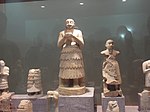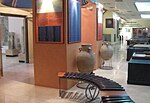National Museum of Aleppo
The National Museum of Aleppo (Arabic: متحف حلب الوطني) is the largest museum in the city of Aleppo, Syria, and was founded in 1931. It is located in the heart of the northern city on Baron Street, adjacent to the famous Baron Hotel and near the Bab al-Faraj Square and Clock Tower. The majority of the museum's exhibitions are devoted to the archaeology of Syria, with most of the finds coming from archaeological sites of the northern part of the country.
Artefacts inside the museum were damaged in the 2023 Turkey–Syria earthquake.[1]
History of the museum
In 1931, under the decision of the Syrian authorities, a small Ottoman palace was designated to become the National Museum in the city of Aleppo. After three decades, the building became too small to host the growing number of exhibited items. Therefore, it was decided in 1966 to demolish the old palace building and replace it with a larger, more modern structure. Construction of the new building commenced after Yugoslav architects Zdravko Bregovac and Vjenceslav Richter's project proposal won first prize for their competition entry.[2]
In July 2016 the museum was hit by numerous missiles and mortar shells fired by rebel forces. This caused extensive damage to the roof and structure of the building. Most of the collection had already been evacuated but concerns have been expressed regarding items which could not be moved.[3][4][5]
Collections

Items from all historical periods are exhibited in the museum. However, the largest sections of the museum are devoted to the Iron Age and the Islamic period. The entrance to the museum is a temple gateway with a female sphinx from the Iron Age (9th century BC) Neo-Hittite settlement of Tell Halaf.
Ground floor
The ground floor consists of two sections: the section of Prehistoric Culture and the section of Ancient Syrian Civilizations. The first section is a large hall containing numerous samples of human items and tools form the Stone Age found in the regions of Aleppo, Ain Dara and Ebla. It also contains the oldest civilized human shelter (8500 BC) brought from Mureybet.
The second section is divide into a group of halls, classified geographically according to the Syrian regions and dedicated to the ancient civilizations of Syria. Many Bronze Age objects from Hama and Ugarit are exhibited in the halls, statues and cuneiform scripts from Mari, as well as pieces discovered by Max Mallowan at the site of Tell Brak. Moreover, Iron Age materials and Assyrian style statues from archeological sites of the Al-Jazeera region, and the Euphrates region could be found.[6]

The main halls of this section are:
- The Hall of Al Jazeera Hills
- The Hall of Mari
- The Hall of Hama Region
- The Hall of Ugarit
- The Hall of Tell Halaf
- The Hall of Arslan Tash
- The Hall of Tell Ahmar
- The Hall of Ancient Statues and Cuneiform Scripts.
- The Hall of Ebla
Second floor
The upper floor of the museum contains three sections:
- The section of Classical Remnants: Exhibits several objects of Greek, Hellenistic, Roman and Byzantine periods, such as coins, mosaics glassware and potteries.
- The section of Arabic-Islamic History: This section contains several Arabic coins, manuscripts, potteries and an Islamic 12th-century tomb and a 12th-century astrolabe.
- The section of Modern Art: Dedicated to the modern artists of Aleppo and other Syrian cities. It contains a scale model of the old city of Aleppo and a sixth-century fantastic mosaic.
Courtyard
The internal courtyard of the museum is home to huge basaltic statues of ancient Hittite and Roman mythological characters and a big third-century mosaic figure. At the external courtyard, monuments of Assyrian, Aramaic, Byzantine and Arabic civilizations are exhibited.[7]
Gallery
-
 Statues at the museum yard
Statues at the museum yard -
 A historical statue from Mari
A historical statue from Mari -
 Statues from Mari in the Aleppo museum
Statues from Mari in the Aleppo museum -
 Inside the museum
Inside the museum -

See also

References
- ^ Hunter, Marnie; Alberti, Mia (February 7, 2023). "UNESCO site 'in danger' faces greater peril after earthquake". CNN. Retrieved 2023-02-10.
- ^ Martina Munivrana, Vesna Meštrić (ed): Richter - Rebel With a Wision, Zagreb, 2017., p. 90
- ^ "UNESCO Director-General deplores heavy damages at the National Museum of Aleppo | United Nations Educational, Scientific and Cultural Organization".
- ^ The National Museum of Aleppo under heavy shelling
- ^ "Cultural Heritage Initiatives". 17 November 2017.
- ^ "Syria gate: Aleppo Museum". Syriagate.com. Archived from the original on 2009-05-26. Retrieved 2009-08-12.
- ^ "Aleppo.us: Aleppo Museum". Aleppo.us. Archived from the original on 2021-02-28. Retrieved 2012-07-13.
- v
- t
- e
- Ancient City of Aleppo
- Citadel of Aleppo
- Al-Madina Souq
- Al-Jdayde quarter
- Central Synagogue of Aleppo
- Al-Shibani building
- Hammam Bab al-Ahmar
- Hammam al-Nahhasin
- Hammam Yalbugha
- Khanqah al-Farafira
- Bimaristan Arghun al-Kamili
- Beit Junblatt
- Beit Ghazaleh
- Beit Achiqbash
- Bab al-Faraj Clock Tower
- Baron Hotel
- Aleppo railway station
- Villa Rose
- Grand Serail of Aleppo
| Historic | |
|---|---|
| Modern |
| Historic | |||||||||
|---|---|---|---|---|---|---|---|---|---|
| Modern |
|
- Bab al-Hadid
- Bab al-Ahmar
- Bab al-Nairab
- Bab al-Maqam
- Bab Qinnasrin
- Bab Antakeya
- Bab al-Jinan
- Bab al-Faraj
- Bab al-Nasr
education
- Aleppo Citadel Amphitheatre
- Aleppo Citadel Museum
- National Library of Aleppo
- National Museum of Aleppo
- Aleppo Centre for Culture and Arts
- University of Aleppo
- Mamoun University for Science and Technology
- Al-Shahba University
- Aleppo College
- École Amal
- International School of Aleppo
- Lycée français d'Alep
- Abd al-Rahman al-Kawakibi
- Al-Ma'arri
- Buhturi
- Harut Sassounian
- Hilarion Capucci
- Ibrahim Hananu
- Jerry Seinfeld
- Joseph Safra
- Levon Ter-Petrossian
- Louay Kayali
- Moustapha Akkad
- Mustafa Bey Barmada
- Nazim al-Kudsi
- Qustaki al-Himsi
- Ronaldo Mouchawar
- Rushdi al-Kikhya
- Omar Abu-Riche
- Paul of Aleppo
- Qustaki al-Himsi
- Saadallah al-Jabiri
- Sabah Fakhri
- Saint Maron
- Simeon Stylites
| Venues | |
|---|---|
| Clubs |
- Rulers of Aleppo
- Kingdom of Armi
- Yamhad
- Palistin
- Bit Agusi
- Aleppo soap
- Dead Cities
- Siege of Aleppo (637)
- Aleppo Codex
- Hamdanids
- Mirdasids
- Zengids
- 1138 Aleppo earthquake
- Siege of Aleppo (1260)
- Battle of Marj Dabiq
- Aleppo Eyalet
- Levant Company
- Massacre of Aleppo (1850)
- Aleppo Vilayet
- Qudud Halabiya
- Baghdad Railway
- Aleppo International Airport
- State of Aleppo
- People's Party
- 1947 Aleppo pogrom
- Chemins de Fer Syriens
- Aleppo Artillery School massacre
- Siege of Aleppo (1980)
- Battle of Aleppo

















